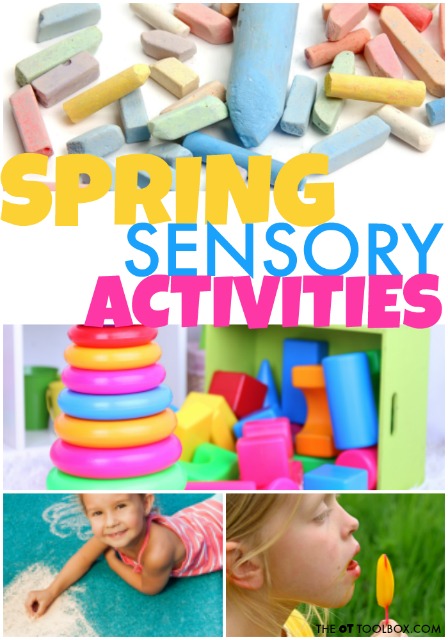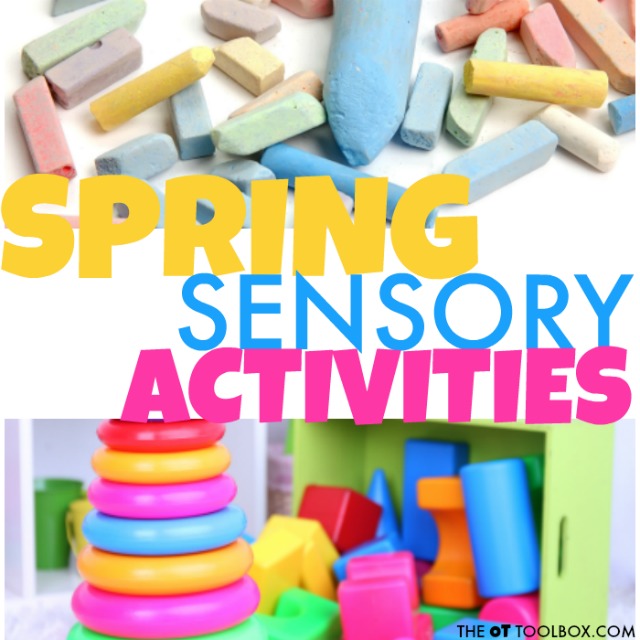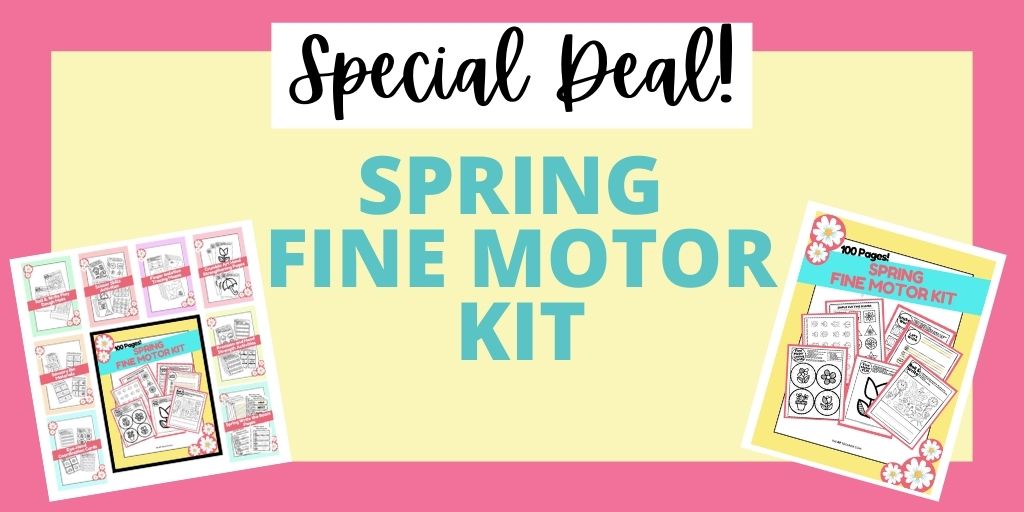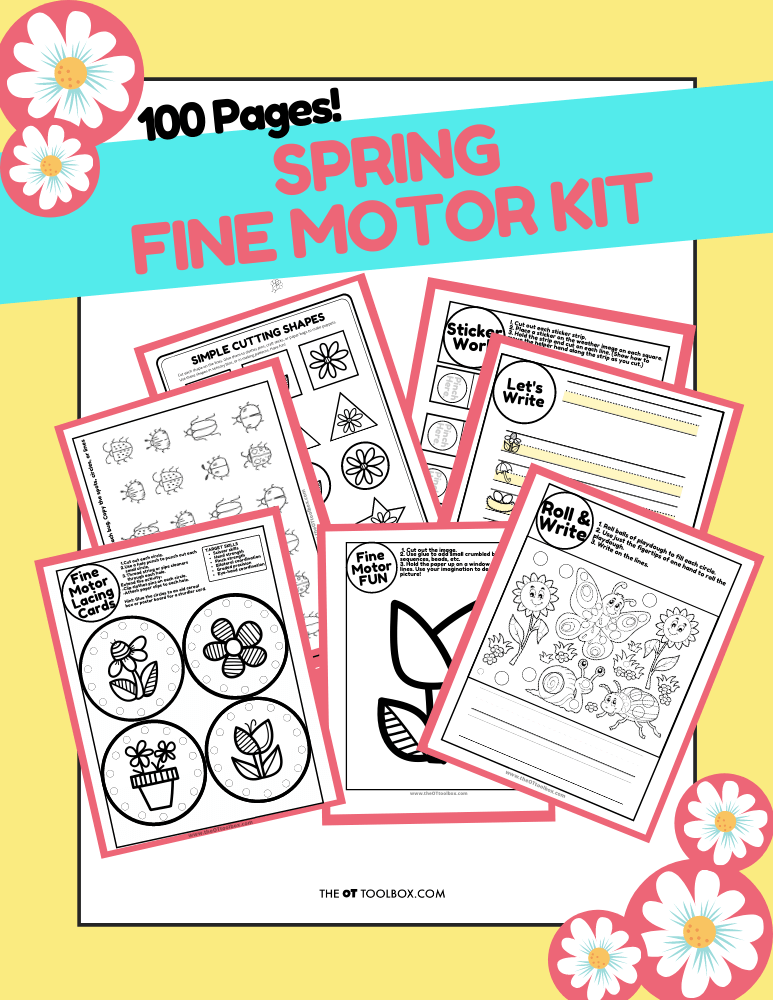Today, we’re talking about all things Spring sensory activities. When it comes to spring and the change in the weather (hopefully), a few sensory-themed activities can be a tool for working on a variety of skill areas, all through play and sensory exploration. These ideas are just one aspect of Spring OT activities that develop skills through play.
Today, we’re going to discuss using sensory activities to address corresponding needs. Because when it comes to sensory processing, there can be related areas that are impacted as a result of sensory information being poorly processed and resulting in functional skills and development being impacted.

Spring Sensory Activities
For the child with identified sensory processing difficulties, an effective treatment plan needs to be established, so that the individual can more effectively participate in functional activities.
In today’s blog post, you’ll find some activities and modifications that can be used in the home, classroom, or therapy clinic. These are Spring sensory activities to add to a therapy plan this time of year. Add them to some of the other ideas being shared this week on our website and in our newsletter to create a themed set of interventions that meet the needs of a full caseload!
Other seasonal occupational therapy activities can be integrated with these sensory ideas. Include aspects of these Spring OT ideas to create a well-rounded lesson plan this time of year:
- Spring Fine Motor Activities
- Spring Gross Motor Activities
- Spring Executive Functioning Activities
- Spring Visual Perception Activities
- Spring Handwriting Activities
- Spring Occupational Therapy Activities
For a more exhaustive set of strategies, activities, and ideas, be sure to grab the Spring Fine Motor Kit (PLUS bonus kit which covers everything you need for Spring Break) that is on sale now for just $10. You’ll be loaded up on all kinds of tools that will last all season long.
Spring Sensory Activities
Let’s go over aspects of play for this time of year that incorporate much-needed sensory input for various areas. We’ll break down the activity ideas by sensory system to get you started.
Spring Proprioceptive and Vestibular Activities
These Spring Sensory Activities are designed to improve discrimination of Vestibular and Proprioceptive Information:
Some kids with poor discrimination of sensory input, especially vestibular and proprioceptive input, may present with poor coordination, posture, balance, attention, and clumsiness, and/or constant fidgeting.
These kiddos may benefit from some resistive work activities.
Try some of these Spring themed ideas to work on these areas:
Spring Heavy Work- Heavy work can be calming as a self-regulation tool. Use these free Spring themed heavy work cards to add activity ideas. They are great for brain breaks and to use in obstacle courses or a transition activity in a visual schedule.
Spring Sensory Stations- Our popular sensory stations printables are great to add movement, heavy work, deep breathing, and mindfulness to the classroom, school hallway, clinic, or home. Print them off, slip them into a page protector, or laminate them, and hang them in a highly trafficked area in the school or classroom. Or, use them in a quiet calm-down corner. These sensory stations offer a chance for self-regulation and sensory input for brain breaks and calming input when kids need them.
Bunny Wall Push-ups- Cut out a pair of bunny paw prints and tape them to the wall. This is a place to hop over to and then perform wall push-ups.
Egg Rubber Bands- Provide heavy work to the hands by wrapping rubber bands around plastic Easter eggs. Kids can try to unwrap the rubber bands and then re-wrap the eggs. Use the bands as a hand exercise for the fingers in extension and in finger flexion.
Tug-of-War- Use a rope or sturdy jump rope to pull heavy items from one location to another. Some ideas include a basket or bin full of books or weights. Transport a stuffed animal or plastic Easter eggs in the basket or bin. Sit or lay on a therapy ball to pull the objects out of the bin. Kids can lay in supine on the therapy ball while pulling the rope, too.
Make a Spring Trail Mix- Add in crunchy and chewy items such as dry cranberries, small, chopped carrots, fruit leather, small pretzel pieces, bunny crackers or bunny pretzels.
Make a Spring Crash Zone- Use heavy blankets, couch cushions, and pillows to create a crash pad area. Hide fake flower tops (remove the stems) in the pillows and blankets. Kids can jump and find various flowers. Give them a specific number or specific color to locate in the jumping area.
Leap Frog- Remember the classic leap frog game? It’s a great Spring sensory activity! Kids can jump over small items or paper lily pads. In a pinch for time? Just use paper plates for your lily pads.
Spring Sensory Ideas for Discrimination of Tactile System
These Spring sensory activities are designed to bring awareness to and to improve a decreased or impaired discrimination of tactile sensory input:
A poor body scheme is common in kids with sensory processing needs. As a result, praxis and fine motor skills can be difficult.
Kids may seek out additional input through their hands by touching everything they see.
Other kids can’t discriminate between light and heavy tactile input.
Here are some spring-themed sensory activities to encourage tactile discrimination:
Use craft sheets and draw flowers or “grass” lines with a ballpoint pen. Then, the child can use a felt tip marker to trace the lines in the craft sheet. Allow them to trace with the ball point pen, too. Using the different writing tools provides various feedback in the resistive surface of the craft sheet. This is a great pre-writing lines activity for younger kids. You can see how we used craft sheets to work on pencil control using this sensory technique in a previous activity post.
Use a vibrating pen- Create a flower shape or egg shape with Wikki Stix. Then, use the vibrating pen to draw lines or color in the parts of the flower/egg. Use cookie cutters to encourage bilateral coordination of an assisting hand and the dominant hand. Vibrating pens provide great sensory feedback to the hands.
Use hot glue or regular school glue to create tracing forms. Write spring words like “sun”, “bee”, “flowers”, “grass”, etc. or trace Spring coloring pages with the glue. Allow the glue to dry and then place another sheet over the hardened glue. Use crayons to shade over the raised lines. Here is an example of how we used glue to practice sight words with DIY crayon rubbings with an emphasis on tactile sensory input.
Spring Sensory Ideas for Somatodyspraxia
Somatodyspraxia is a common occurrence in those with sensory processing challenges.
Somatodyspraxia is seen via frequent falling, poor posture, balance, tripping, running into or bumping into others or objects, trouble managing small items or manipulating objects as a result of poor fine motor skills, along with poor body scheme and organization.
Kids who struggle to process tactile input and vestibular information can be challenged with praxis concerns.
Here are some Spring Sensory Activities designed to address somatodyspraxia:
Spring obstacle course- Make an obstacle course that requires various motor movements, motor planning, changes in body position, and organization of body actions. This can easily be accomplished with pillows, couch cushions, chairs, laundry baskets or buckets, and everyday items. Use colored Easter eggs or fake flowers to carry through the obstacle course while challenging praxis.
Bean Bag Toss- Use several small baskets or buckets to work on motor planning with bean bags. Use visual and verbal instructions to place or toss the bean bags into the targets with either one hand or the other (or a foot by placing the bean bag on the toes!). Use simplified instructions to follow instructions. Downgrade the activity by having the child repeat instructions and steps of the direction.
For more assistance with somatodyspraxia, add more cues, simplified instructions, visual cues, and single-step motor tasks.
Spring Sensory Activities for Bilateral Coordination
Bilateral coordination difficulties are common for the child with sensory processing challenges.
This looks like uncoordinated movements in hopping, jumping, jumping jacks, kicking a ball, catching a ball, running, climbing, etc.
This might carryover to fearfulness when challenged to complete these tasks. You may also see trouble with hand dominance or left/right discrimination.
Here are some Spring Sensory Activities that can help:
Play Simon Says with a Spring Theme- Encourage bilateral coordination movements and alternating motions to follow directions. Use a Spring theme by saying “hop like a frog”, “crawl like a caterpillar”, etc. Use stickers or a stamp to identify the left or right hand and foot for these actions. Use our free Spring Heavy Work cards in a Simon Says activity this time of year.
Play Hopscotch- Draw a hopscotch board and draw lily pads or spring flowers on the board. Kids can hop onto the squares. Also try jumping with one or both feet onto the target square.
Spring sensory Activities to Address Tactile Defensiveness
Tactile defensiveness can present in many ways, including a refusal to touch certain materials, resistiveness to certain clothing fabrics, food preferences, or avoidance of certain materials or activities.
Adding heavy input or slow, calming vestibular input can be helpful in some individuals.
Try some of these Spring themed sensory activities:
Deep Pressure- Add weights to the wrists or a weighted lap pad along with heavy work to the hands. Try using a large eraser to erase flowers drawn on construction paper. Ask the child to erase the flower completely. Try using lighter pencil strokes and reducing the amount of erasing needed. This is one way to work on pencil pressure, too.
Flower-Push- Add proprioceptive input to a gross motor activity that provides heavy work through the whole body. Draw a flower or sun on two paper plates. Place them on the floor and ask the child to place their hands on the flower picture while they get into a push-up position. The child can push the flowers across the floor.
Caterpillar Roll- Use a blanket to roll the child up in a log position. The child is now a caterpillar! Add slow and heavy input through up and down the length of the child, using whole hands and slow movements.
Spring Sensory Activities to Address Gravitational Insecurity
Sensory challenges sometimes present with gravitational insecurity. This might look like the child that has trouble being positioned off the ground, such as on a raised surface like a swing, bleachers, on an elevator, or escalator, etc. Calming proprioceptive input can be helpful.
Here are some Spring Sensory Activities that can help:
Add Spring stickers to a weighted lap pad or wrist/ankle weights. Make it fun!
Flower Breaths-Try deep breathing activities such as imagining blowing a dandelion fluff across a field. Use deep and slow breaths to imagine moving those flower fluffs away. This can be helpful before participating in an activity that requires motion that can be a challenge for the child, such as when riding in a car.

More Spring Sensory Activities
Looking for more ways to promote sensory activities through movement and play? The Spring Fine Motor Kit gets kids moving in just the right ways to build strong and efficient hands. When you grab the kit now through the 22nd, you’ll also get a BONUS resources full of sensory strategies to meet all sensory processing needs.
Spring Fine Motor Kit
Score Fine Motor Tools and resources and help kids build the skills they need to thrive!
Developing hand strength, dexterity, dexterity, precision skills, and eye-hand coordination skills that kids need for holding and writing with a pencil, coloring, and manipulating small objects in every day task doesn’t need to be difficult. The Spring Fine Motor Kit includes 100 pages of fine motor activities, worksheets, crafts, and more:

- Lacing cards
- Sensory bin cards
- Hole punch activities
- Pencil control worksheets
- Play dough mats
- Write the Room cards
- Modified paper
- Sticker activities
- MUCH MORE
Click here to add this resource set to your therapy toolbox.

Grab your copy of the Spring Fine Motor Kit and build coordination, strength, and endurance in fun and creative activities. Click here to add this resource set to your therapy toolbox.
In this BONUS set, you’ll find: Spring Visual Perception Worksheets- Print these off and slide them into a page protector. Use them to work on visual perceptual skills like form discrimination, visual closure, figure ground, and visual processing skills like tracking, scanning, etc. Use manipulative items to work on fine motor skills with these worksheets such as play dough, slime, Wikki Stix, yarn, craft pom poms, or other items.
Spring Fine Motor and Gross Motor Activities- Add these ideas to therapy home programs to work on pencil grasp or core strength. Use these ideas in therapy warm-ups, or to add movement to a child’s day.
Spring Themed Brain Breaks- Cut up these cards and use them to add movement and motor skills into the classroom or home. It’s a great way to re-charge!
Spring Themed Handwriting Practice Prompts- There are two pages of writing prompts that are ONLY in list form. That means kids don’t need to write out sentences while working on letter formation, spacing and size. They can work on all of the handwriting skills they need in a short list that is interest-based, making it motivational for them. And, the list format is a quick way to sneak in handwriting practice!
OT Homework Sheet- Sometimes, it takes extra practice to make skills “stick”. When parents help in practicing therapy activities, it can make a difference in carryover. You’ll find a done-for-you OT homework sheet to use in weekly homework activities OR for use as a home exercise program!
Client-Centered Worksheet- When our kiddos have a voice in their therapy, carryover and goals can be more meaningful to them. Use this worksheet to come up with Spring activities that meet the needs of a child, while taking into considerations that child’s interests and strengths to make activities meaningful.
Sensory Activities and More- All of these extras were added to the already well-rounded Spring packet that includes activities designed around each of the sensory systems. You’ll find 13 pages of proprioception activities, vestibular activities, tactile activities, oral motor activities, etc. And, they include ideas to extend the activity to include eye-hand coordination, body scheme, oculomotor control, visual perception, coordination, and motor planning.

Colleen Beck, OTR/L has been an occupational therapist since 2000, working in school-based, hand therapy, outpatient peds, EI, and SNF. Colleen created The OT Toolbox to inspire therapists, teachers, and parents with easy and fun tools to help children thrive. Read her story about going from an OT making $3/hour (after paying for kids’ childcare) to a full-time OT resource creator for millions of readers. Want to collaborate? Send an email to contact@theottoolbox.com.






